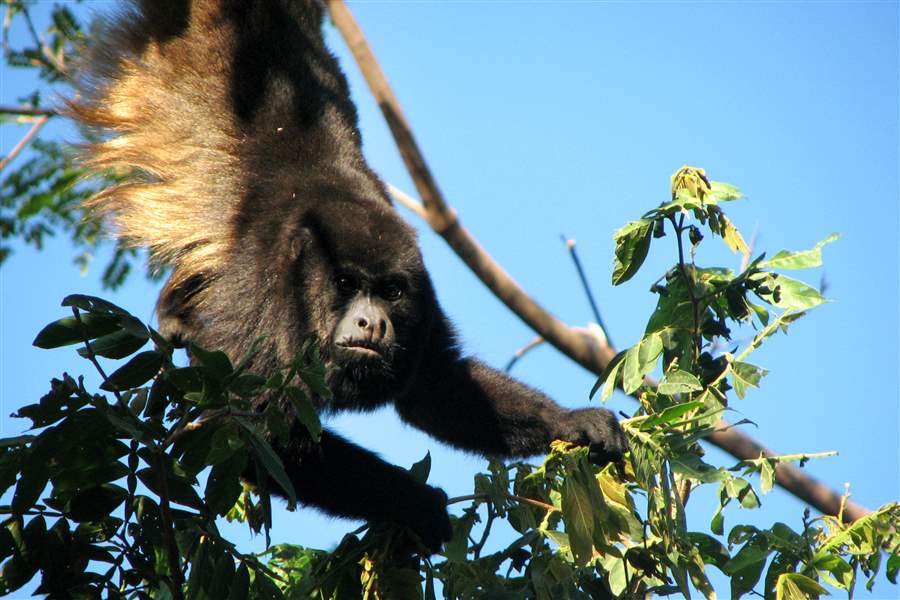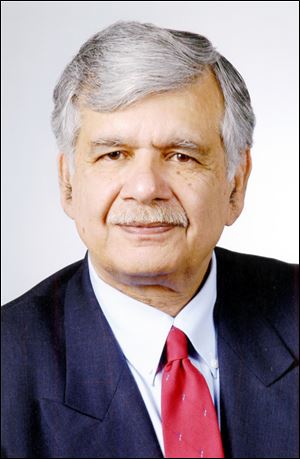
Costa Rica is a model for the rest of the world
2/25/2018
A howler monkey hangs from a tree above a rented beach house in Playa Guiones, Nosara, Costa Rica.
BLOOMBERG NEWS

Dr. S. Amjad Hussain.
Costa Rica is a small Central American country wedged between Panama, to the south, and Nicaragua, to the north. This country has fascinated people around the world for its progressive policies, high literacy rate, and a knack for conservation. It has no standing army, has no quarrels with its neighbors, and has often played a major role in helping resolve regional conflicts.
I came here with a few of my Toledo friends for a week of learning about ecology, biodiversity, and land management. I am left with a nagging question: Why do other countries in the Western Hemisphere, as well as developing countries around the world, not follow the example of Costa Rica?
Read the last column by S. Amjad Hussain
Approximately the size of West Virginia, it has a population of about 5 million, and is the most stable and democratic country in the Western Hemisphere. It spends almost 7 percent of its budget on education compared to the global average of 4.4 percent. As a result, it has the highest literacy rate, 93 percent, in the Americas. By setting aside a fourth of its land as wildlife refuge, it has become a haven for eco-tourism.
The country has no standing army. In 1948, there was a short but bloody civil war fought between a faction of the army and politicians. The army prevailed and took the unprecedented step of disbanding itself. Today there are no insurrections and no guerrillas fighting the government from mountainous hideouts. One can travel at will even in the remote areas without any fear. Ticos, as the Costa Ricans call themselves, are kind people who dispense their hospitality in a low-octane, charming demeanor.
In an hemisphere full of regional conflicts, Costa Rica has managed to remain neutral and has helped diffuse many regional conflicts. In 1987, Oscar Arias, the then-president of the country, received the Nobel Peace Prize for his regional peace efforts.
One cannot escape, however, the universally pervasive American influence here. From the ubiquitous Coca-Cola to Alka-Seltzer, the country is awash with American products. Even in the countryside, the billboards announce the presence of Budget Rent-a-Car, Papa John’s Pizza, Burger King, McDonald’s and Pennzoil. One America businessman told me that compared to other Latin American countries, it was easy to do business in Costa Rica.
Despite the abundance of Americana and American products, the countryside is still very Latino. It is pristine and idyllic. Lush green fields of sugar cane, as well as banana and pineapple plantations, are interspersed with tiny villages of small, brightly painted cinder-block homes with gardens and farm animals. And there are always some people whiling away the time in the piazza in the center of the village. Life is unhurried, and it is enjoyable to be in the slow lane for a change.
It is precisely because of the slow pace of life, coupled with the relatively low cost of living and public safety, that many American and Canadian retirees decide to spend their golden years here.
It is amazing that a small, underdeveloped country could achieve so much success in educating its population and become a praiseworthy example of conservation. It has done that by arranging its priorities to reflect its long-term goals.
Compare Costa Rica’s resolve at land conservation with the recent actions of Trump administration to drastically shrink the size of two national monuments in southern Utah. The size of the Bears Ears and the Grand Staircase-Escalante monuments were reduced from a combined total of 3.2 million acres to 1.2 million. There is the potential for uranium, oil, and gas development in the area. The battle cry “drill, baby, drill” popularized by Sarah Palin is back in full force.
There are, however, hurdles in the way of recent presidential action. The 1906 Antiquities Act was designed to provide safeguards to historic, cultural, and natural landscapes in the country. Mr. Trump’s decision is being challenged in the courts on the grounds that the Antiquities Act does not allow the president to undo previous designation of the land.
While the challenge to Mr. Trump’s decision winds through the courts, it may be worthwhile for our Interior Secretary Ryan Ziunke to come to Costa Rica to learn a thing or two about conservation and land management. He could fly economy class, stay in the rain forest, and observe first-hand the ecological and monitory benefits of conservation.
Adios, nos vemos luego. (Good-bye, until we meet again.)
S. Amjad Hussain is an emeritus professor of surgery and humanities at the University of Toledo. His column appears every other week in The Blade. Contact him at aghaji@bex.net.